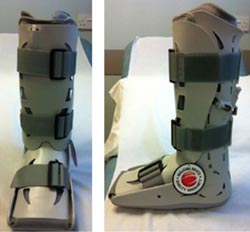What will the surgery involve?
i. Anaesthetic – usually a general anaesthetic is required; local anaesthetic will usually be injected around the nerves that supply sensation to the foot and ankle (usually applied near the knee- popliteal nerve block) alternatively it is injected around the incisions at the end of the operation. The local anaesthetic should reduce the discomfort after the surgery and if a popliteal nerve block is used the foot and ankle are likely to remain ’numb’ for 12-24 hours.
You will have a chance to discuss your anaesthetic with the anaesthetist before the operation.
ii. Incisions – a longitudinal slightly curved incision is made over the Achilles tendon (a further incision may be required on the inside of the foot if the tendon to the big toe needs to be ’harvested’).
iii. The surgery – The exact surgery required will depend on exactly where the tendon is abnormality of the tendon is in the tendon above (non insertional) or at its insertion into the heel bone (calcaneum) (insertional).
If non insertional: The lining of the tendon may need to be removed and a small tendon that runs alongside the Achilles may need to be released.
Alternatively the abnormal area of the Achilles may need to be removed, if more than half of the tendon is removed it is likely to be weakened such that is usually reinforced using the tendon that bends the big toe which is transferred into the heel bone.
If insertional: if the problem is a bony spur impinging in the tendon (Haglunds deformity) then removing this may be all that is required. If the abnormality of the tendon is more significant, then it may need to be elevated off the bone, the abnormal tendon excised and the remaining tendon reattached. Again the tendon may need to be reinforced with transfer of the tendon of the big toe into the heel.
iv. Stitches – Removable, non-dissolving sutures will be used to close the skin. These will be removed at your appointment about two weeks after surgery.
v. Dressings – Special dressings are applied. These should be kept in place until you are seen in the clinic two weeks after the surgery.
If the surgery involves removing or excising abnormal tendon (with or without transferring the tendon from the big toe), then a plaster ’back slab’ (covering the back and the sides of the ankle up to the knee) is usually also required, if so this will be changed to a further plaster or a walking boot at the two week appointment. This will be kept in place for the following 4 weeks.
The plaster should be kept dry, applying a waterproof cover when showering is useful, the most commonly used can be found at www.limboproducts.co.uk
What happens after the surgery?
i. Going home – This will either be the same day or the following morning depending on the time of surgery and home situation.
ii. Pain relief – The local anaesthetic ankle should provide some pain relief, but you will be supplied with pain relieving tablets by the hospital (usually co-codamol and tramadol) these should be taken regularly initially. You can gradually reduce these as your pain allows (tramadol is the stronger pain killer).
You will find it more comfortable to keep your foot up on a chair, if possible above the level of your heart, as much as you can for the first two weeks after surgery. This will help reduce the swelling and therefore also help wound healing.
 iii. Walking – For the first two weeks you should not apply any weight through the foot/ ankle.
iii. Walking – For the first two weeks you should not apply any weight through the foot/ ankle.
If you did not require a plaster then you will be able to start increasing the amount of weight you place on your foot at that stage.
If you required a plaster, you will usually be able to place all of your weight on the operated foot/ ankle after two weeks when the new plaster or walking boot (see photos, right) has been applied.
iv. Driving – You will not be able to drive until you can walk without crutches confidently. If you the surgery is on your left foot and you have an automatic car you may be able to drive after your two weeks, but you should check with your insurance company first.
If the surgery was on your right foot and you did not required a plaster after surgery then you will be able to start driving about 3 weeks after the surgery. If you required a plaster, it is likely to be 8 weeks before you will be able to drive, but again you should check with your insurance company first.
v. Follow up – You will be seen in the outpatient clinic at:
2 weeks after surgery for sutures to be removed. If you were placed in a plaster at the time of the surgery you will then be placed in a plaster or a walking boot.
6 and 12 weeks after surgery depending on the exact nature of the surgery undertaken, if you have been placed in a walking boot then this will usually be removed six weeks after surgery.
You will be referred for physiotherapy, when this commences will depend on the exact surgery undertaken.
v. Return to work – Approximately:
If plaster required:
Office job – 6 weeks
Mobile job requiring driving – 12 – 14 weeks
Manual labour – 4 months
If plaster not required:
Office job – 2 – 4 weeks
Mobile job requiring driving – 4 – 6 weeks
Manual labour – 6 – 8 weeks
What are the risks of the operation?
There are a small number of risks of surgery including infection, nerve damage, blood clots, ongoing pain and the need for further surgery (please see General Risks of Foot and Ankle Surgery for further information)
